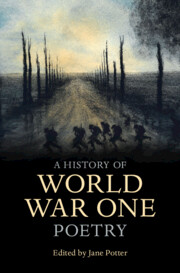Book contents
- A History of World War One Poetry
- A History of World War One Poetry
- Copyright page
- Dedication
- Contents
- Illustrations
- Contributors
- Acknowledgements
- Introduction
- Part I Literary Contexts
- Part II Nations and Voices
- Part III Poets
- Chapter 20 Non-Combatants
- Chapter 21 Edward Thomas (1878–1917)
- Chapter 22 Guillaume Apollinaire (1880–1918)
- Chapter 23 Siegfried Sassoon (1886–1967) and Edmund Blunden (1896–1974)
- Chapter 24 Anna Akhmatova (1889–1966)
- Chapter 25 Mary Borden (1886–1968)
- Chapter 26 Georg Trakl (1887–1914)
- Chapter 27 Isaac Rosenberg (1890–1918)
- Chapter 28 Ivor Gurney (1890–1937)
- Chapter 29 Wilfred Owen (1893–1918)
- Chapter 30 David Jones (1895–1974)
- Part IV
- Bibliography
- Index
Chapter 30 - David Jones (1895–1974)
from Part III - Poets
Published online by Cambridge University Press: 18 January 2023
- A History of World War One Poetry
- A History of World War One Poetry
- Copyright page
- Dedication
- Contents
- Illustrations
- Contributors
- Acknowledgements
- Introduction
- Part I Literary Contexts
- Part II Nations and Voices
- Part III Poets
- Chapter 20 Non-Combatants
- Chapter 21 Edward Thomas (1878–1917)
- Chapter 22 Guillaume Apollinaire (1880–1918)
- Chapter 23 Siegfried Sassoon (1886–1967) and Edmund Blunden (1896–1974)
- Chapter 24 Anna Akhmatova (1889–1966)
- Chapter 25 Mary Borden (1886–1968)
- Chapter 26 Georg Trakl (1887–1914)
- Chapter 27 Isaac Rosenberg (1890–1918)
- Chapter 28 Ivor Gurney (1890–1937)
- Chapter 29 Wilfred Owen (1893–1918)
- Chapter 30 David Jones (1895–1974)
- Part IV
- Bibliography
- Index
Summary
First and foremost a visual artist, David Jones is able to give his poetry unifying, symbolic spatial form that makes it unique in modern literature. Based on his experience in the trenches, his war epic, In Parenthesis, is polyphonic in modes and motifs and defamiliarising in allusive scope. It has two kinds of overall form: one spatial, which through paired images centres on the universal soldier, who symbolises knowledge; the other temporal, involving two teleological movements ultimately culminating in the myth the Queen of the Wood, who symbolizes desire. His second poem, The Anathamta expresses his original theory of culture. Also epic-length, it is open in temporal form, varying in voice and viewpoint as it zigzags through prehistoric and historic time. Unlike other modern long poems, it is formally whole, unified by a chiasmic, spatial structure that symbolizes the Eucharist’s containing and being contained by every facet of human experience. The mid-length poems of his sequence, The Sleeping Lord, are Roman and Celtic in topic, except for the final poem, which is a return to the Great War. Thematically, they express the universal human tension between love and utility.
- Type
- Chapter
- Information
- A History of World War One Poetry , pp. 488 - 504Publisher: Cambridge University PressPrint publication year: 2023



